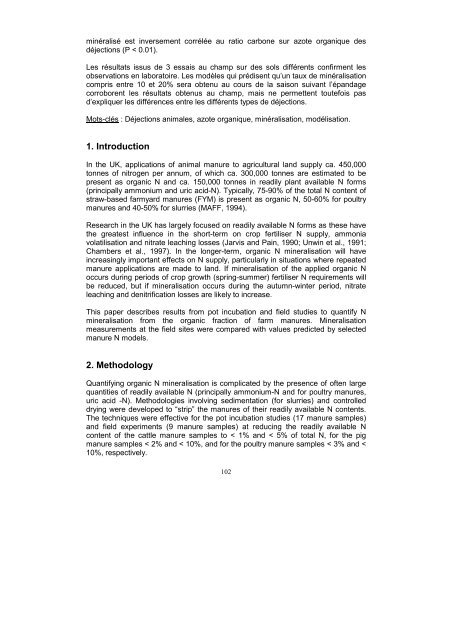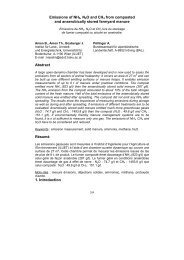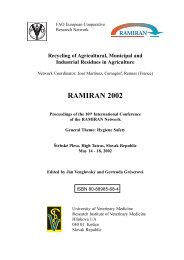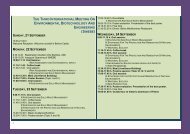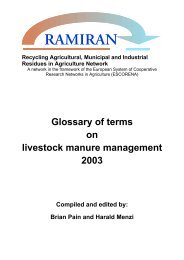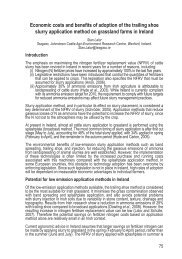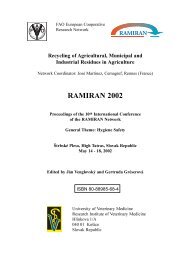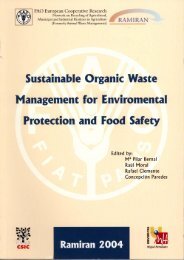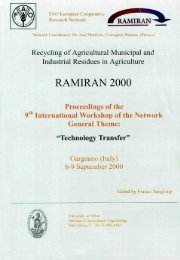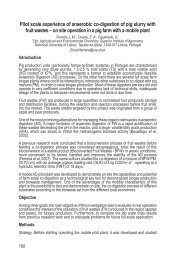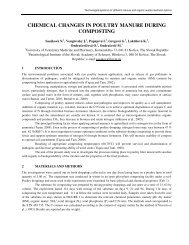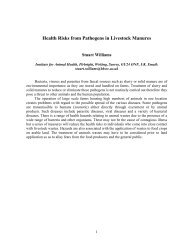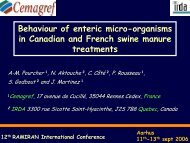Field studies of farm manure organic nitrogen mineralisation - Ramiran
Field studies of farm manure organic nitrogen mineralisation - Ramiran
Field studies of farm manure organic nitrogen mineralisation - Ramiran
Create successful ePaper yourself
Turn your PDF publications into a flip-book with our unique Google optimized e-Paper software.
minéralisé est inversement corrélée au ratio carbone sur azote organique des<br />
déjections (P < 0.01).<br />
Les résultats issus de 3 essais au champ sur des sols différents confirment les<br />
observations en laboratoire. Les modèles qui prédisent qu’un taux de minéralisation<br />
compris entre 10 et 20% sera obtenu au cours de la saison suivant l’épandage<br />
corroborent les résultats obtenus au champ, mais ne permettent toutefois pas<br />
d’expliquer les différences entre les différents types de déjections.<br />
Mots-clés : Déjections animales, azote organique, minéralisation, modélisation.<br />
1. Introduction<br />
In the UK, applications <strong>of</strong> animal <strong>manure</strong> to agricultural land supply ca. 450,000<br />
tonnes <strong>of</strong> <strong>nitrogen</strong> per annum, <strong>of</strong> which ca. 300,000 tonnes are estimated to be<br />
present as <strong>organic</strong> N and ca. 150,000 tonnes in readily plant available N forms<br />
(principally ammonium and uric acid-N). Typically, 75-90% <strong>of</strong> the total N content <strong>of</strong><br />
straw-based <strong>farm</strong>yard <strong>manure</strong>s (FYM) is present as <strong>organic</strong> N, 50-60% for poultry<br />
<strong>manure</strong>s and 40-50% for slurries (MAFF, 1994).<br />
Research in the UK has largely focused on readily available N forms as these have<br />
the greatest influence in the short-term on crop fertiliser N supply, ammonia<br />
volatilisation and nitrate leaching losses (Jarvis and Pain, 1990; Unwin et al., 1991;<br />
Chambers et al., 1997). In the longer-term, <strong>organic</strong> N <strong>mineralisation</strong> will have<br />
increasingly important effects on N supply, particularly in situations where repeated<br />
<strong>manure</strong> applications are made to land. If <strong>mineralisation</strong> <strong>of</strong> the applied <strong>organic</strong> N<br />
occurs during periods <strong>of</strong> crop growth (spring-summer) fertiliser N requirements will<br />
be reduced, but if <strong>mineralisation</strong> occurs during the autumn-winter period, nitrate<br />
leaching and denitrification losses are likely to increase.<br />
This paper describes results from pot incubation and field <strong>studies</strong> to quantify N<br />
<strong>mineralisation</strong> from the <strong>organic</strong> fraction <strong>of</strong> <strong>farm</strong> <strong>manure</strong>s. Mineralisation<br />
measurements at the field sites were compared with values predicted by selected<br />
<strong>manure</strong> N models.<br />
2. Methodology<br />
Quantifying <strong>organic</strong> N <strong>mineralisation</strong> is complicated by the presence <strong>of</strong> <strong>of</strong>ten large<br />
quantities <strong>of</strong> readily available N (principally ammonium-N and for poultry <strong>manure</strong>s,<br />
uric acid -N). Methodologies involving sedimentation (for slurries) and controlled<br />
drying were developed to “strip” the <strong>manure</strong>s <strong>of</strong> their readily available N contents.<br />
The techniques were effective for the pot incubation <strong>studies</strong> (17 <strong>manure</strong> samples)<br />
and field experiments (9 <strong>manure</strong> samples) at reducing the readily available N<br />
content <strong>of</strong> the cattle <strong>manure</strong> samples to < 1% and < 5% <strong>of</strong> total N, for the pig<br />
<strong>manure</strong> samples < 2% and < 10%, and for the poultry <strong>manure</strong> samples < 3% and <<br />
10%, respectively.<br />
102


